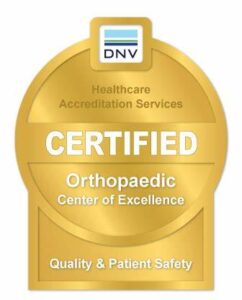Dr. Paul Scibetta, Jr., an orthopedic surgeon at Elliot Orthopaedics, joins the podcast to discuss Carpal Tunnel Syndrome (CPS) and the different treatment options that are available to patients.
Dr. Scibetta says, “It’s a relatively very common condition in the United States. If you look at the Bureau of Labor statistics, it’s one of the most frequently reported causes of work-related injuries. It accounts for numerous lost days of work and medical expenses, estimated at about $2 billion a year.”
Elliot Orthopaedics is an Orthopaedic Center of Excellence.

Listen to the full 10-minute episode.
Podcast Transcript
Scott Webb (Host): Carpal tunnel syndrome, or CTS, can affect our ability to work and quality of life. I am joined today by Dr. Paul Scibetta, Jr. He’s a board-certified orthopedic surgeon specializing in hand and wrist injuries and conditions. And he’s here today to explain CTS and how we can help folks who suffer from it.
This is Your Wellness Solution, the podcast by Elliot Health System and Southern New Hampshire Health, members of SolutionHealth. I’m Scott Webb. Doctor, thanks so much for your time today. We’re going to learn today about carpal tunnel syndrome. And I think that CTS is one of those things that folks think they understand, but it’s great to have an expert here. So, let’s start there. What is carpal tunnel syndrome? What causes it, and who’s at the highest risk for developing it?
Dr. Paul Scibetta, Jr.: Carpal tunnel syndrome is a condition that occurs when the median nerve in the wrist becomes compressed or irritated. This compression can lead to various symptoms, including things like pain, tingliness, numbness, and weakness in the hand or the fingers. People may also experience pain in the hand that can radiate into their forearm when they have carpal tunnel syndrome. And sometimes these symptoms can occur at night, and they can even disturb your sleep or wake people up.
Host: Yeah. So, we have a sense there, like what are the symptoms and how we might, you know, begin to suspect, “Oh, I think I might have carpal tunnel.” So, what causes it? And are some folks at higher risk?
Dr. Paul Scibetta, Jr.: Well, common causes of carpal tunnel syndrome include things like repetitive motion, hand movements, activities such as typing, or maybe using tools. Sometimes I have patients that have assembly type of work, where they are doing repetitive motion over and over. Now, there are also some medical conditions that can cause carpal tunnel syndrome, things like inflammatory arthritis, diabetes, thyroid disorders, and many people might know of someone who had carpal tunnel syndrome when they were pregnant.
Host: Oh, that’s interesting. I’ve never heard that connection before. So yeah, it’s a combination of things, right? It’s a behavior, lifestyle, perhaps maybe some genetics mixed in there. So, you gave us a sense here of like what people are doing to cause it and what they’re experiencing. So then, what’s the threshold then for someone to decide whether or not to see a doctor? At what point should we do that? And then, maybe talk a little bit about surgery, if that’s indicated.
Dr. Paul Scibetta, Jr.: First, let me talk about the people that are affected. This is a common condition in the United States. And if you want to talk about who gets it or what part of the population, the incidence is estimated somewhere between 3-6% of the U.S. population will have symptoms of carpal tunnel syndrome. And it’s a relatively very common condition in the United States.
If you look at the Bureau of Labor Statistics, it’s one of the most frequently reported causes of work-related injuries, which is fascinating. It accounts for numerous lost days of work, medical expenses, estimated at about $2 billion a year. Unbelievable. Now, carpal tunnel syndrome usually tends to affect women more than men. The highest incidence is somewhere in women around the ages of 45 to 60. And then, the causes are some of the items that I mentioned before.
Host: Yeah. So then, let’s talk about, so whether it’s men or women, but as you say, more women than men, but in general, once someone has CTS or is suffering from CTS, whatever the right way is to put that, then when do we see a doctor? When is it too painful or too debilitating, you know, and necessitating seeing a doctor? And then, at what point might surgery be indicated?
Dr. Paul Scibetta, Jr.: If you start to suspect that you have carpal tunnel syndrome, it’s best to consult a health care professional right away, such as your primary care provider, so that you get an examination, you get an accurate diagnosis, and you get the appropriate treatment options. So, if you have symptoms, again, of a tingliness, a numbness, in your fingers, and predominantly it affects the thumb, the index, and the middle finger. Carpal tunnel syndrome will never affect your little finger or your small finger. If you get any of these symptoms, tingliness, numbness, pain, losing grip strength, dropping objects, you should be evaluated.
Now, I mentioned things that can cause it, such as repetitive motion activities. You could also get carpal tunnel syndrome symptoms from things that vibrate. People that use power tools as part of their occupation, people that recreationally operate motorcycles or snow machines here in the Northeast, they’ll start to get these symptoms, and you really shouldn’t ignore it, and you should, you know, seek some care from your primary care provider or from whoever, you know, takes care of your medical problems.
Now, when you want to get into treatment, of course, the diagnosis will be made by an examination. And the provider might order a specialized test called an EMG or electromyography. Think of it simply as a nerve conduction study. This is a test that can be done by either a neurology group or physiatry group where electrodes are placed on the arms, and the conductance of electricity in the nerves in your arms is sort of recorded and measured. And this can help confirm the diagnosis of carpal tunnel syndrome in a patient and also quantify it and give the provider information on, well, how severe is this? Is it a mild case? Is it a moderate case? Is it a severe case? And then, that’s going to help impact treatment.
And so, when you talk about treatment for carpal tunnel syndrome, we start very conservatively. We usually start with things like anti-inflammatory medications or non-steroidal anti-inflammatories. Sometimes we can use topical products. Many times, we’ll recommend a splint, especially at nighttime. Nighttime splinting for carpal tunnel syndrome is very common, and it helps to keep the patient’s wrist in a very neutral position to help reduce the symptoms and the nighttime pain that wakes people up.
Now, when you find a patient that has carpal tunnel syndrome and the conservative management doesn’t seem to work for them, and again, this can be splinting and anti-inflammatories, even some home exercises or occupational therapy, then we move into some more invasive ways to treat it. And the two options that are pretty standard are a corticosteroid injection or a surgical release.
Host: Yeah. Maybe let’s go through that a little bit. As you say, you start conservative, and you work your way towards steroids and possibly surgery. So, how do you know? You as an expert obviously would know, but for the rest of us, you know, how do we know when it’s bad enough where we might need to consider the more invasive options?
Dr. Paul Scibetta, Jr.: Well, when the symptoms are constant, they’re not intermittent, you’re getting numbness in your hand all the time. You’re finding yourself taking breaks at work. You’re shaking your hand out to wake it up, as people describe to me. If your doctor has gone through conservative management and you’ve just not improved at all, and you give it time, I mean, you do conservative management for four to six weeks before you move into something else. If that fails, then it’s time to consider do you want to try a corticosteroid injection? Do you want to try a surgical release? Now, sometimes the nerve conduction studies will also help guide you. When the nerve conduction studies are very severe and there’s some changes in the hand in severe carpal tunnel, including some muscle atrophy, you might go into surgical release as opposed to a cortisone injection. But it’s really up to the patient.
Host: You know, I’m sure folks would want to know, all right, well, how do we prevent this? So, as you say, a lot of times it’s this repetitive motion. It’s things that folks do for a living. They have to use those power tools. They have to type, whatever it might be. So, how do we then prevent this when folks have to do these things for work?
Dr. Paul Scibetta, Jr.: It’s difficult. One thing you could try to do if you’re in an occupation where there’s a lot of repetitive motion activities, you quite simply need to take brief, but frequent breaks. So, if you’re doing a lot of keyboard use, you need to stop. You need to do stretches. There are tendon gliding exercises that you can do, and you could probably obtain that from your physician or from an occupational therapist. There are other ways to get exercises for carpal tunnel, but you can do some things like that.
Now, vitamin B12 has sometimes been looked at as a vitamin that can improve nerve conduction, but I can’t tell you that there’s any data that states that we always use that in carpal tunnel syndrome. But I mean, it is something that could be considered. But I would say overall, it would be, if you have this at work, you want to take frequent breaks, brief ones. Stop, do some stretches. You could also try to use a keyboard, making your workstation more ergonomically friendly with changing heights and maybe even putting some padding underneath your wrists when you’re working.
Host: Yeah. Great advice from an expert today. I just want to finish up here and, you know, get a sense of what we can do. Let’s say, it sounds to me like a lot of folks suffer from CTS, and maybe they don’t see their providers. But if people are sort of treating themselves at home, home remedies, things like that, what can we do to relieve the symptoms at home and maybe not get to those invasive things?
Dr. Paul Scibetta, Jr.: Relieving the symptoms at home- you can try to control pain and discomfort with anti-inflammatories. You can try nighttime splinting and home exercises. But there isn’t much more beyond that. If you have symptoms that do not resolve after several weeks of trying conservative management, you really need to have somebody take a look at it.
The downside to not treating it is that you can get a nerve injury to the median nerve, and this will manifest itself as muscle atrophy in your palm. So, at the base of your thumb, there’s a muscle group that can become atrophied if that nerve signal is cut off for too long. And it’s very difficult to reverse an injury like that.
Host: I see what you mean. Yeah, so it’s like, all right, try to prevent if we can, right? Take those breaks while we’re working, adjust the height of our keyboards, things like that. Do what we can, of course. But as you say, at some point when this persists, when it goes on too long, it’s time to see your provider, perhaps see a specialist and have a real proper thorough diagnosis and let the experts do their thing, right?
Dr. Paul Scibetta, Jr.: Yes.
Host: Absolutely. Well, listen, I appreciate your time today. As I told you before we started recording today, I want to learn more about CTS, about carpal tunnel syndrome today. And I have, so thanks so much and you stay well.
Dr. Paul Scibetta, Jr.: Well, thank you very much and have a wonderful day. Thank you.
Host: And for more information, go to elliotthospital.org/orthopaedics. And if you enjoyed this podcast, please be sure to tell a friend and share it on social media. This is Your Wellness Solution, the podcast by Elliot Health System and Southern New Hampshire Health, members of SolutionHealth. I’m Scott Webb. Stay well, and we’ll talk again next time.


